Visitors to John Pearce Transport (JPT) in Glynneath, West Glamorgan might wonder if someone hadn’t read the memo from the Welsh Government banning new road construction, apparently to help save the environment.
The A465 Heads of the Valleys road is currently undergoing major reconstruction to make it dual carriageway – when no doubt a camera-enforced average speed limit of 50mph will be introduced – and the dusty landscape is dominated by earthmovers and cement mixers. The construction work is also for a new windfarm which is set to be one of the biggest onshore installations in Europe.
Our host, JPT MD Clive Davies, pictured, explains that the A465 improvement project was begun before Brexit with EU funding and so will be completed in 2025. “It will probably be the last new road to be built in Wales,” he says. “It will open up this valley to the Midlands and bring more business to the industrial estates along this road.”
Davies is the son-in-law of the haulier’s founders John – also known as Jack – and Joyce Pearce, who are now both retired. They still live next door to the company’s headquarters - and their daughter and son-in-law Hayley and Clive Davies, whose house overlooks the depot. Before starting in haulage Jack worked in a local open cast coal mine while Joyce was a nurse.
“He had a cousin who owned a factory and he said to Jack ‘if you get a truck you can do our transport’,” says Davies. “That got him started and then he started to pick up other customers.”
The firm is celebrating its 50th anniversary in 2023 after being founded in September 1973 with a single truck in nearby Rhigos. In 1978 it moved to its present site which was then just had a one bay workshop; since then the site has been expanded to its present-day scale, with 16,000sq ft of warehousing and a two-bay workshop where the firm still does most of its R&M.
“In 1991 Jack and Joyce built the warehouse,” says Davies. “At the time was I was working with JPT’s biggest customer, TRW. In 1993 I came to work here and then we developed the rest of the site with a bigger yard and bought a second warehouse in 1995.”
Some of the work for car parts distributor TRW involved exports to the continent, but in common with most UK hauliers JPT pulled out of international haulage due to the stiff competition from the Eastern Europeans for whom the export leg was just a backload.
Before then, however, the haulier brought in bulk ammonium nitrate from France which it stored in the depot in Glynneath before it was mixed with water to make liquid explosive for the mining industry.
“We used to have 40 1-tonne bags in the yard,” Davies recalls. “It couldn’t come through Calais so we had to go to Zeebrugge and bring it in from there. The truck was on the front of the boat so if anything happened they could push it off.
“Then they started packing it in 1kg bags, still a 24-tonne load, but it was then alright to come through Calais.”
In 2003 JPT joined The Pallet Network, and today the network makes up around 30% of its volumes, with seven or eight trunks a night running to the TPN hub in Sutton Coldfield.
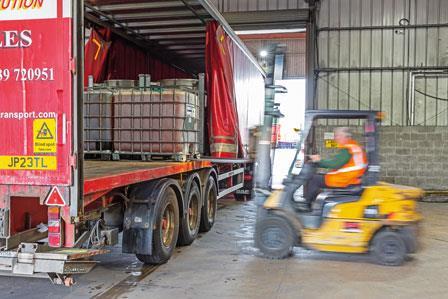
“We were balanced for years but we are putting a little more in than we get back now,” says Davies. “We put in around 1,700 pallets a week and bring back 1,400. The problem in recent years has been that the networks grew so quickly, at 10% or 15% every year, and we have to try and stick with it otherwise we become unbalanced and then it isn’t worth doing.
“At the moment we have grown slightly ahead of the network but they are moving to a new hub next year and they wouldn’t spending £75m if the volumes were staying the same. So they will push the members to sell more. Hopefully the hub will perform better and get the trunks back to us earlier - and get our volumes back in line.”
Like many pallet network members Davies says delivery rates need to increase, especially for hauliers like JPT with large areas to cover.
“We have a huge area but we need it to balance ourselves,” says Davies. “The networks want members to have a smaller area so we aren’t sending trucks 40 miles from base. But look at where we are. There are no factories in these mountains.
“Last year, when the fuel price was going up, we could put a surcharge on our own customers but there was no surcharge on the network delivery rates. So if you were a net deliverer you were really in trouble.”
Davies expects more consolidation among the UK’s eight pallet networks which, apart from the acquisition of Fortec by Pall-Ex two years ago, have continued to grow strongly as independent and fiercely competitive rivals.
While it has some full truckload business, JPT has always had a strong groupage business.
“We have always been a multidrop haulier and looked to build loads with proper traffic sheets,” says Davies. “Back in the 1990s we would be charging £80 a pallet – now we are selling them for £40 anywhere in the country. The networks have driven the cost of transport down and obviously it works. But you have to have a mix of business and I don’t know how hauliers manage if they are just doing pallet network deliveries.”
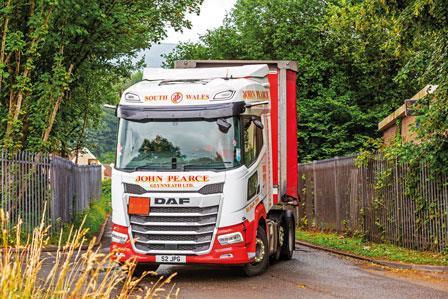
The issue of weight limits on tail-lift pallet deliveries has calmed down since the RHA and HSE published guidelines advising hauliers to require their drivers to carry out ‘dynamic risk assessments’ of the safety of every delivery, rather than set an arbitrary weight limit.
Palletline voluntarily limited standard tail-lift deliveries to 750kg but TPN still allows a maximum of 1,000kgs with an electric pump truck.
“All the networks want to reduce the limit,” says Davies. “Some of the roads we deliver to in the Rhondda Valley are very steep and with a tonne on the pump truck running down the tail-lift you have to be really careful. We do a lot of training with the drivers on safe pallet deliveries, including our new immersive training scheme.”
JPT’s customer base is very varied, with clients in the water industry, medical supplies, mobility aids, lead for the building industry, food stuffs and automotive.
Davies hasn’t seen much effect of Brexit, though he says the months immediately after withdrawal saw many local companies asking for help with exports.
“It hasn’t made a huge difference,” he says. “I haven’t seen a lot of industry come back to Wales.”
The company, whose motto is ‘Being on time is our business’, saw its fleet grow rapidly after Davies’ arrival in 1993. “We had 15 trucks then and now we run 60 trucks and 90 trailers,” he says. “We streamlined after 2008 but got through it OK and we have grown again over the last seven or eight years.
“We offer a really good service and support our customers. We try to form partnerships and show them where they can save money on their transport. That has been reasonably successful over the years.”
The fleet is mainly DAF though Davies still buys some Mercedes-Benz.
In February 2022 it became one of the first UK operators to take delivery of two New Generation DAF XF 480 FTG tractors, and in November last year it purchased three more new DAF XF artics and two new Mercedes-Benz Actros rigids.
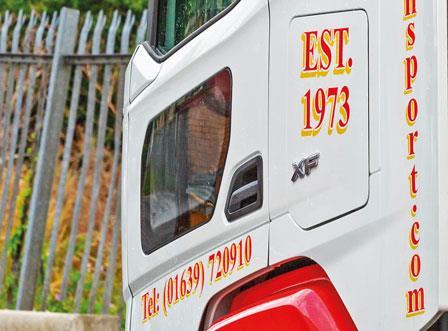
“We bought them with the window in the passenger door to be ready for the London DVS,” says Davies.
“We also specified the DAFs with their Digital Vision cameras instead of mirrors – we already had some of the Mercs with them. Some drivers love them but others don’t.
"The last two Mercs we bought, they couldn’t supply them with MirrorCam so they have standard mirrors. It doesn’t matter so much on a rigid but with an artic the cameras are more of a benefit. But some drivers won’t drive them.”
The artics clock up around 130,000kms a year while the rigids do less than half that. There is no fixed replacement schedule. “We run them as long as we can,” says Davies. “We run them up the road until they get too tired and then we put them on more local runs. We have a couple of 10-year-old DAFs still running but they need to be moved on now. They have done a good job for us and have done 1.4m kms so you can’t knock the value for money.”
While Davies is seeing parts availability improve he is shocked by the increase in prices.
“So far in 2023 [by June] we have spent over £80,000 on replacement parts,” he says. “That compares with £38,000 in the whole of 2020. That is on top of the rise in fuel prices, a 20% pay rise for drivers and higher pallet network charges. We have to manage our margins really carefully.”
Unusually these days JPT does as much R&M work inhouse as possible, but finding skilled technicians is a struggle for it as well as its local dealers.
“The dealers can’t get fitters and neither can I,” says Davies. “Getting trucks in to the dealers for the jobs we can’t do is always a problem. To be fair to both dealers, Euro Commercials [Mercedes-Benz] and Watts Truck & Bus [DAF], they look after us and do everything they can to support us.”
JPT has installed an R2C workshop management system to help manage costs and help it move towards Earned Recognition at some point in the future. It is using Tachomaster to check compliance with drivers’ hours rules and is installing in-cab card readers which will automatically download tacho data after every shift rather than the current weekly read of the drivers’ cards.
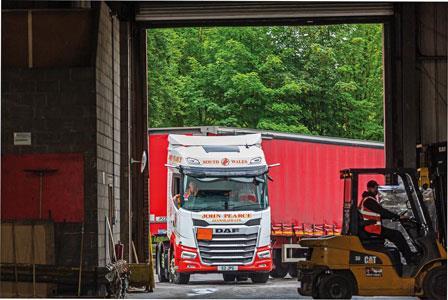
While Davies knows electric trucks are coming he cannot see how or where they will be able to recharge.
“When I talk to people round here I tell them ‘when the electric trucks come, you will have to turn your TVs and kettles off’,” he says. “How are we going to do it? We run eight trunks to the hub every night and normally do 10 run outs on top of that. So let’s say we have 18 trucks out on the road overnight.
“If they go electric we can’t send them out as they will be charging after working all day, so there will be another 18 lorries that we would have to run while the others are charging. Where is the environmental benefit in that?
“We have 20 rigids mainly on TPN work, and they are out and back, so it is possible to make them electric.
“Unless you can run an electric truck the same as we do today, we will have to manufacture many more trucks. I look at the yard and wonder where we are going to put all these lorries and chargers.”
Getting drivers and warehouse staff engaged with training
While in some ways JPT is still a traditional family haulier, Davies believes in adopting new technology. He has recently created an innovative online “immersive” training programme that he is keen to sell to other operators after proving its success with his own staff.
“If you don’t move with the times you get left behind,” he says. “When vehicle tracking and mobile phones came in we all said ‘the drivers will never have it’ but if you don’t go with it, you will be stuffed.”
Custom-made video of JPT’s vehicles and warehouse keeps the training relevant to real-life operations and interactive tests at the end of each module keep the trainee engaged. The ‘extended reality (XR)’ video is shot in 360 degrees so the trainee can move the camera angle around. Modules include safe movement around the warehouse, safe loading, unloading and coupling of trailers, daily vehicle walkaround checks, driving licence checks and any health issues the company should be aware of.
The training is compulsory for all new starters as part of their induction. But the plan is to refresh the content every six months and by tracking each employee with a unique user name and PIN the company can ensure everyone gets regular, up to date training.
Changing the image of transport remains a huge challenge
Davies is happy to put his customers’ branding on the curtains of his trailers to give them some free publicity, and was surprised when one soft drinks bottler turned him down. “They said ‘we don’t think trucks are environmentally friendly’,” he says. “I said ‘how do your customers think your products get to them?’ But that is the way some people think about road transport, as a dirty, stinking industry. It is our job to change that but it is very difficult.”
It isn’t just customers’ perceptions that need to change – if the industry is to recruit the skilled young people it needs attitudes everywhere to be more closely aligned with reality.
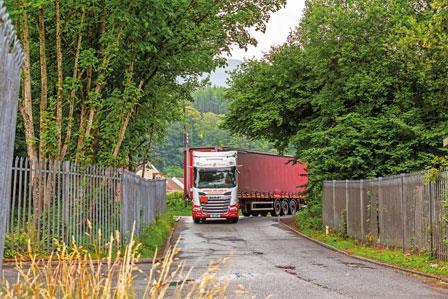
“About six years ago we were recruiting a new office manager so we went to Neath and Talbot College to look for someone finishing A-levels, not wanting to go to university and looking for a good job locally,” Davies says. “We did a presentation to some of the students and told them about the transport industry. Then we handed out the application forms – but didn’t get a single application.
“The college didn’t see road transport as a good industry to work in. All the kids seemed to want to work in call centres after that documentary [BBC Three’s ‘The Call Centre’]. In the end we found a great girl at a jobs fair and she stayed with us for five years before going to the steel works. Maybe she will be back.”
JPT has had more success bringing in van and Class 2 drivers and training them up to Class 1.
“We have trained up six or seven people that way,” says Davies. “We had already started before the driver shortage really hit because we were having problems recruiting. People really appreciated it and we have kept a lot of those great guys who weren’t in the industry before.”
One of those new recruits was female – a Polish lady who is currently driving a 7.5 tonner. “She is loving it,” says Davies. “But not many ladies come looking for those jobs. Multi drop tailift deliveries are not easy and can be physically demanding. It’s a tough job.”
Succession planning
The Pearce family including Davies and his wife Hayley hold all the shares in JPT and have no plans to sell up.
Davies has three boys, aged 30, 28 and 11, and none have so far shown any interest in joining the family firm.
“I’ve always told them ‘go and do whatever you want to do and don’t think you have to come here’,” Davies says. “Both the older boys have worked here so they know the score. They need to go and learn other things and maybe bring them back.”
Davies himself only got his transport manager CPC in 1991 while working for JPT’s customer TRW and came to the family haulage firm in 1993 when his parents-in-law still ran the business.
“I took over the planning, workshop and staffing side of the business,” he says. “I’ve been here 30 years and it has developed over the years. It is still a family and we all help each other. We live next door to each other so we have to get on!”













